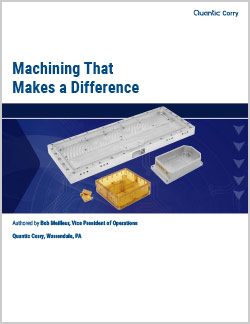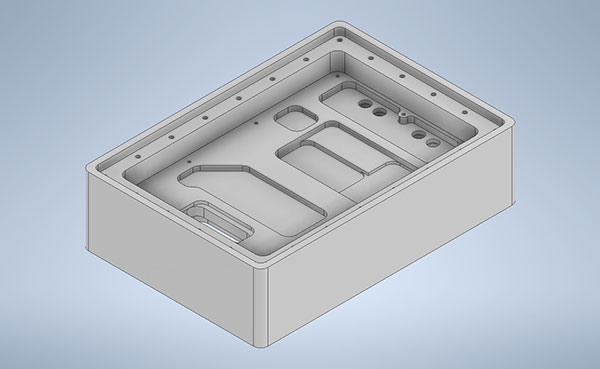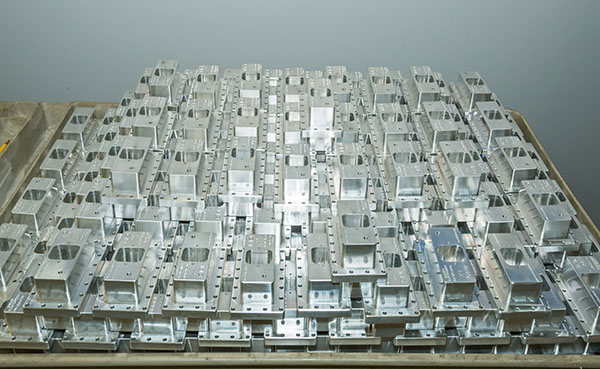Machining That Makes a Difference
Learn everything you need to know about precision machining!
The Quantic Corry team is excited to announce that we have developed another free highly-informative white paper. Our new comprehensive guide contains everything you need to know about machining that our fellow engineers will find both interesting and helpful.

Our new white paper: Machining That Makes a Difference is full of great information, including:
- Why we rely on CNC systems for achieving tight, repeatable tolerances
- How an in-house coordinate measuring machine works
- Materials used in our building stages
- Plating and coating processes for microelectronic packaging
Download your FREE copy now.
Call us with your questions at724-940-7556, ext. 138
Download White Paper:Machining That Makes a Difference
Abstract
Precision machining is an important and often overlooked ingredient for designing and manufacturing high-performance, high-frequency components and assemblies. Well-equipped machine shops for electronic packaging work with materials, such as stainless steel, aluminum, Kovar, high-strength plastics, and novel composites. Electrical connections are achieved by means of plated conductive metals, such as silver, tin, and gold. And, Chem Film coating can be added for surface corrosion protection on aluminum. This white paper will provide an inside look at one of the more elite machine shops for electronic packaging. The experts at Quantic Corry can harness six full-featured multiple-axis CNC systems for both high-volume manufacturing and repeatability within 0.001 inches. It will detail the benefits of in-house testing for mechanical measurements of shock, vibration, and hermeticity as well as electrical measurements through millimeter-wave frequencies. Finally, this white paper will explain how customers can best work with a machine shop capable of creatively and reliably adding input, output, and internal thru-holes to designs to transform mechanical drawings and CAD files to real-world prototypes with fast turnaround times.
Introduction
Assembling reliable, high-performance electronic packaging calls for the right blend of materials, machining, and measurements. Quality microelectronic packaging services require the tools, manufacturing experience, and expertise to convert a physical design layout or computer-aided design (CAD) file into the electronic packaging that meets or exceeds a customer’s expectations.

Fig. 1: The Quantic Corry machine shop is ISO 9001 certified and ITAR registered.
What type of tools are needed to produce high-performance electronic packaging capable of supporting high-speed digital and high-frequency RF/microwave/millimeter-wave (mmWave) circuits and subassemblies?
Those tools must support current trends in military packaging for decreased size, weight, and power (SWaP), and in general, for ongoing miniaturization with effective thermal management. Maintaining reliable signal and power interconnections in smaller packages becomes especially challenging with the minute dimensions of circuit assemblies at mmWave frequencies as well as the typical mix of different substrate materials in digital or mixed-signal assemblies.
But a machine shop with the proper tools and manufacturing processes, such as Quantic Corry, can deliver packaging solutions that exceed the most challenging design and simulation expectations.
Essential tools for electronic packaging fabrication include computer numerically controlled (CNC) machining centers (Fig. 2) capable of forming package parts with the high resolution and repeatability needed for the small dimensions of mmWave interconnections. CNC machines rely on subtractive manufacturing—removing small amounts of a stock material, such as aluminum or stainless steel—to form a part with the shape and dimensions required as part of a package. CNC machines perform as drills, mills, and lathes to remove material from starting stock, with computer precision and control of the machining in all three axes, enabling the formation of three-dimensional parts. This contrasts with newer, additive manufacturing processes, such as computer-controlled 3D printing, in which content is added to a base material to form 3D parts.

Fig. 2: Our machine shop counts on CNC systems for achieving tight, repeatable tolerances in the latest materials.
Properly programmed CNC machines are capable of very high resolution and repeatability, within thousandths of an inch, when working with base materials, such as aluminum, brass, copper, stainless steel, and Kovar. When weight is a concern, engineered plastics can also be used as a base material for package structures. Such precision is possible with manual machining procedures, such as drilling and milling, especially when a requirement is for a small quantity of parts.
But, when larger volumes are needed, CNC machines are capable of outstanding repeatability when comparing the dimensions of multiple parts. This can be critical when an electronic assembly is designed for an application with limited space, such as a surveillance or communications module for an unmanned aerial vehicle (UAV) or drone. When packaging circuits and assemblies for applications requiring multiple channels with matched amplitude and/or phase characteristics, repeatability is a critical requirement and well-maintained and programmed CNC machines can mass produce parts with very tight tolerances.
Machining housings for RF, microwave, mmWave components and devices requires precision as well as the metrology measurement capability to verify the precision. Using an in-house coordinate measuring machine (CMM), Quantic Corry’s machine shop verifies dimensions and tolerances with micrometer precision.

Fig. 3: Dimensions of both small and large parts can be measured with high resolution and accuracy with our machine shop’s Micro-Vu Excel 662HC system.
Our CMM is capable of 0.05 μm linear resolution in all three axes. Although, it can also perform measurements with 500 mm/s measurement speed (Fig. 3). All dimensions and tolerances are checked and verified for the smallest machined parts, even for the dimensions required for packages operating at mmWave frequencies.
Forming metal parts into precision microelectronic packages requires extensive knowledge of the materials in use and the processes, such as welding and brazing, required to join metal parts securely and reliably (see table).
Laser welding and brazing may both be involved in the fabrication of a microelectronic package to join similar metals, such as copper to copper, or different metal parts, such as copper to stainless steel. However, they are much different manufacturing processes. Also, lids can be laser welded as part of a hermetic package required for space and aerospace applications.
Welding joins metal parts together by melting and fusing the metals of the different parts, often with a filler material added as part of the fusion process. Fusion takes place by concentrating heat at a joint, to elevate temperatures beyond the melting points of the metals to be joined and any filler material. Welding provides an extremely strong joint, usually stronger than the base materials.
Brazing also uses a filler material and can form strong joints between metal parts to be joined. Although, this will not be as strong as the joints formed by welding. In contrast to welding, brazing is performed at the melting point of a filler material (above +900°F), but below the melting points of the metals to be joined. When the materials cool, a strong joint is formed. By working at a lower temperature than welding, there is less danger of causing warpage or distortion in the metals to be joined. The cost of generating lower temperatures than welding is typically less than the related costs for generating the temperature required for welding.
When joining metal pieces, such as in the fabrication of a microelectronic package, the characteristics of the metals to be joined and the configuration of the joint determine whether brazing or laser welding makes more sense. Brazing is usually more practical when joining very thin metal sections to a thicker base, since the heat required for welding can damage the thinner metal sections. Brazing is also usually applied when joining dissimilar metals. Engineers who understand metal properties as well as the different stress points that occur in different joint configurations can apply that knowledge and experience when making a choice between brazing and laser welding in the fabrication of rugged, high-performance packaging.
Making Connections
Ensuring proper power connections and signal routing through an electronic package is as important as its mechanical strength. And, it requires well-controlled plating of conduc-tive metals and command of coatings that provide protection for intricately detailed cir-cuits and assemblies.
A machine shop capable of producing housings for high-speed digital and high-frequency RF/microwave/mmWave printed-circuit boards (PCBs) and assemblies must be capable of plating conductive metals, such as electrical feedthrus and interconnections. It should also have experience with applying protective coatings for packaging and assemblies that will be subject to harsh operating environments, such as a suitable chemical coating to guard against corrosion from salt water in maritime applications.
The machine shop at Quantic Corry brings experience and diversified expertise to plating and coating processes for microelectronic packaging. Reliable electrical contacts and interconnections are formed by plating contact points with conductive metals, such as gold, silver, electroless nickel, tin, and tri-metal (white bronze). Circuit and assembly protection is provided by working with advanced coating materials, such as Chem Film chemical conversion coating for use with aluminum and aluminum alloys and qualified to MIL-DTL-5411 for all branches of the military.
In collaborating with the company’s component designers in packaging filters, switches, attenuators, amplifiers, and other components based on hard (ceramic) and soft substrates, our machine shop’s engineers have developed and refined reliable packaging solutions for many high-speed, high-frequency circuits. Among their many specialties is the installation of plated feedthrus for packaged assemblies of almost any geometry, with 100% guaranteed yield on all feedthru installations.
Our team has built a solid reputation for reliable packaging that manages the most severe operating environments (short of deep space). We also have a full understanding of the relationship of PCBs and packages. That knowledge base includes failure analysis (FA) or the capability to find and avoid reasons for a failure in an electronic design, such as a weak mechanical joint or poor solder joint. Quantic Corry’s mature brazing and welding processes provide the mechanical integrity needed for achieving outstanding protection of packaged parts even under high shock and vibration conditions, such as those found in avionics systems.
We have years of experience. And, our team’s experience with analyzing different soldering approaches has provided an understanding of solder “aging” mechanisms and how to overcome solder fatigue in packaged assemblies, even when they are exposed to severe operating conditions and environments.
By analyzing different solder joint geometries, we know how to find the optimum geometries, which can minimize solder joint failures. The high-quality plating processes employed at Quantic Corry also lends itself to the production of packaging with high reliability, since wire-bond adhesion strength can be increased by plating the attachment surface with the optimum conductive metal for that type of wire bond.
Of course, our many years of machining experience and expertise must be backed by the right tools for optimum results. The Quantic Corry machine shop is well equipped with the latest state-of-the-art machining equipment, including CNC mills, lathes, surface grinders, and wire-bonding machines. Good command of the CNC systems has resulted in high repeatability of manufactured parts and microelectronic packages with excellent amplitude and phase matching.
Our typical repeatability is within ±0.001 inches for all machined materials. Such tight dimensional control of machined parts enables electronically matched packaging, even at the small wavelengths of mmWave circuits and assemblies. Our manufacturing equipment assists in the manual fabrication of specialized custom packaging solutions in small volumes, but it also supports the production of packaging solutions in high volumes, such as mmWave modules for Fifth Generation (5G) wireless networks.
Our machine shop is ISO 9001 certified and registered to International Traffic in Arms Regulations (ITAR) for defense services, products, and data. It is well equipped for collaborating closely with customers to find practical, reliable packaging solutions for the harshest military environments as well as when tackling difficult miniaturization and SWaP packaging goals.
Despite the challenge of developing packaging solutions with high-mechanical integrity, electrical consistency, and even hermeticity, our products are developed in a timely fashion. Our turnaround times are less than two weeks from receiving a customer’s CAD files to developing a physical prototype.
Testing the Hardware
Machining high-quality package solutions that must perform at Gb/s digital speeds or at mmWave frequencies requires the precision of manual and automated manufacturing equipment as well as the knowledge of experienced team members. But, verifying the performance of redesigned or new packages and enclosures requires access to both mechanical and electrical test equipment in order to verify physical dimensions and perform accurate amplitude and phase measurements well into the mmWave frequency range.
Test capabilities were not developed overnight, of course. However, they have been per-fected because of our company’s efforts in designing and manufacturing active and pas-sive RF/microwave components, such as amplifiers, attenuators, filters, and switches.
In assembling the measurement capabilities to accurately characterize its own RF components, we have created a test facility with enough capacity and capability to provide full DC and RF electrical testing of all package and enclosure designs through 40 GHz. The measurement laboratory features high-frequency test instruments, such as synthesized signal generators, microwave spectrum analyzers, digital storage oscilloscopes (DSOs), and microwave vector network analyzers (VNAs).
The automated test systems also enable system-level testing of packaged multifunction parts, such as switch-filter assemblies (see “Find the Right Channels with Switched Filter Banks”) for coaxial interconnections to 40 GHz. In addition, our test facility is capable of very specialized, non-RF measurements, such as package hermeticity and humidity testing.
Getting Started
Component designers and developers at Quantic Corry have learned to work with different software simulation tools when modeling the performance of different types of package transmission lines, plated feedthrus, and interconnects, such as Ansys HFSS. Our 3D electromagnetic (EM) simulation software assists in designing and simulating high-frequency electronic products, such as antennas, antenna arrays, RF/microwave components, high frequency, high-speed interconnections, IC packages, and PCBs. Such software tools can also model and predict the performance of packages with the strictest electromagnetic-compatibility (EMC) requirements.
Engineers at Quantic Corry have come to better understand the nuances of our customers’ CAD software and the files representing a package design, and they can transform those files into prototypes very quickly. Corry’s engineers can work with CAD files from leading design software venues, such as 3D package files from AutoCAD® and CAD files from version 10 (V10) of Mastercam. We offer fast and simple integration from a customer’s computer to our machine shop.

Fig. 4: Machining a component begins with CAD files containing essential parameters for the CNC systems to track.
To efficiently transform a CAD file to a prototype component, the CAD file must be validated, during which time geometry, 3D annotations, and other parameters are checked for consistency with reference files and the CNC systems. CNC systems at Quantic Corry are regularly calibrated so that a customer’s CAD files (Fig. 4) can be converted into physical prototypes in the minimum CNC machining iterations possible.


Fig. 5: CNC files are quickly transformed into prototypes (left), which upon customer approval, can just as quickly be turned into high-volume production runs (right).
Evaluation of a machined prototype (Fig. 5, left) involves extensive mechanical and electrical testing before the prototype is approved for large-volume production runs (Fig. 5, right).
Quantic Corry’s machine shop operators benefit from proximity to high-frequency component designers, including active and passive components. We understand the need to support current trends in densely integrating multiple high-frequency functions to achieve miniaturized assemblies.
Machined packages and other components can be final solutions or parts of highly- integrated solutions that can be fully tested for high-speed-digital (HSD) and high-frequency analog performance through mmWave frequencies. The machine shop can work at many different levels of integration, from component through subsystem levels, aided by such specialized capabilities, such as design and development of EMI shielded housings, feed-through installation, hermetic seal testing, and wire bonding.
Fast turnaround time may be important, but at the Quantic Corry machine shop, that will never be a reason to compromise mechanical or electrical performance. Our machine shop has full access to the test instruments needed to verify these claims.
